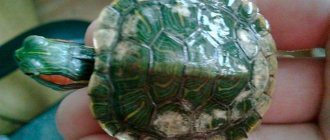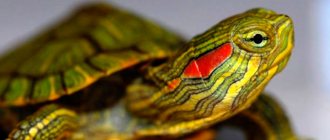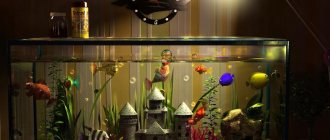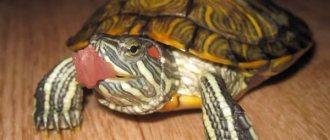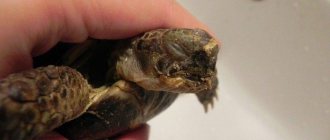Red-eared turtles are cute pets, whose popularity is due to the animals' unpretentiousness and longevity. With proper care and a suitable environment, turtles can live for decades, however, like every living creature, they are susceptible to diseases such as otitis media, obesity, conjunctivitis and other ailments. Diseases of the red-eared turtle usually appear due to inappropriate housing and diet, some of the ailments lead to the turtles dying. To avoid sad consequences, reptile owners should know the signs and causes of diseases, and what to do if their pet gets sick.
Signs of illness
The main symptomatic manifestations of turtle diseases:
- the animal stays on the surface of the water for a long time;
- swelling of the eyes, purulent discharge;
- weakness;
- loss of appetite;
- feces with blood;
- white coating;
- shell detachment;
- softness of the shell;
- foam at the mouth.
Another warning sign is a long stay at the bottom of a reservoir, although in some cases turtles may simply fall asleep at the bottom. This will not mean that she has any health problems, but she needs to be woken up and moved to another place, otherwise the animal may die.
If there are any signs of illness, the turtle should be shown to a specialist. Don't put off visiting your doctor.
Pneumonia and complex rhinitis
The reason why the red-eared slider's eyes do not open and swelling of the eyelids is observed may be pneumonia and complex rhinitis.
When a pet coughs, floats on the surface, or rolls over on its side, this indicates pneumonia.
The disease should be treated by a specialist. After consultation with him, you can do inhalations with chamomile at home. They need to be done the same way as for humans. Their duration is 10 minutes. All this time, the turtle must be held in your hand and placed on a sieve. You cannot use a metal colander for this purpose, otherwise you may burn the reptile.
Then dilute the chamomile infusion to a temperature of 40-45 degrees and place the turtle in it for at least 20 minutes. The water temperature must not be less than 30 degrees.
After which the turtle is placed in a dry container for 4 hours and heated to at least 35 degrees.
The procedure will be repeated morning and evening for a week.
Complex rhinitis has similar symptoms to pneumonia. The main difference between the disease is the pet’s open mouth and air bubbles at the nostrils.
It can be provoked by:
- pet hypothermia;
- hypovitaminosis A;
- contaminated water, in this case you will have to rinse the reptile’s nasal passages with chamomile infusion or furatsilin solution using a syringe without a needle.
Antibiotic therapy is prescribed, the dosage of the medicine must be calculated by the doctor.
Why do turtles get sick?
The causes of disease development are associated with provoking factors:
- decreased immunity due to relocation, acclimatization, or changes in living conditions;
- poor nutrition: lack of vitamins or obesity due to overeating;
- injury;
- change in water temperature;
- contacts with infected animals.
Factors provoking eye diseases
The reasons why a reptile's eyes do not open can be very different. Therefore, helping an animal may differ.
If the red-eared turtle does not open its eyes, then first you should make sure that it is sleeping. To do this, you need to observe your pet for 24 hours. Prolonged sleep and passivity of the animal may indicate the onset of the disease, even if its eyes are not yet cloudy or closed.
In this case, you need to adjust the conditions for keeping your pet as quickly as possible. This can cause the disease:
- feeding errors;
- cold water in the terrarium;
- lack of UV rays;
- dirt in the terrarium.
If all these factors are eliminated, and the red-eared turtle does not open its eyes within 6 hours, it means that it is sick.
Red-eared turtles: diseases
Fungus in the red-eared slider
Spots on the shell of a red-eared slider may indicate the development of a fungus. She can pick up the fungus from other inhabitants of the aquarium. In case of fungus, you need to treat the affected areas with potassium permanganate and monitor the condition for four days. If the condition worsens, you need to go to a specialist.
Pneumonia in a red-eared turtle
Pneumonia or pneumonia occurs in a turtle due to hypothermia. This is facilitated by low water temperatures, moving, and climate change. It is important to diagnose the disease in time and provide assistance to the reptile, since pneumonia in turtles is life-threatening. Symptoms of the disease in red-eared turtles appear within a day. The turtle spends a lot of time on land, floats to the surface of the water, becomes weak, and refuses to eat. With pneumonia, the turtle is physically unable to sink to the bottom, so this sign should not be missed.
How to treat pneumonia? It is recommended to consult a doctor who will prescribe medications. The specialist will definitely prescribe injections into the muscle, which will speed up the healing process. There are many traditional ways to treat pneumonia in turtles, but it is better to trust a specialist.
Eye diseases of red-eared turtles
Common diseases of red-eared turtles are eye inflammation. If your red-eared slider's eyes are swollen, red, or covered in pus, see a doctor. Swollen eyes are caused by poor diet or polluted water. What to do: during treatment, it is important to feed your pet properly and include vitamins and carotene in the diet. Changing the water is mandatory.
Otitis media in a red-eared turtle
If the cheek is swollen or there are red stripes on the head, the turtle is developing otitis media. The tumor can be small or large, treatment methods are different and are selected by the doctor. The cause of otitis media is hypothermia or injury.
Peeling skin
The skin may peel due to the turtle's natural growth or due to illness. Often the skin peels off when a specific area is injured. If fed improperly, the turtle's body develops a vitamin deficiency, which affects the condition of the skin. Peeling of the skin is caused by a lack of vitamins A and B. In some cases, peeling is caused by an excess of vitamins, so if the skin is peeling, it is recommended to consult a doctor who will determine the cause of the development of the pathology. Treatment is carried out depending on the root cause: if there is a lack of vitamins, complex vitamin supplements are prescribed; if there is an excess, the doctor changes the diet. If the skin peels off due to other diseases, representing a concomitant symptom, the doctor directs his forces to fight the underlying disease. When cured, the skin will recover without additional therapy.
Peeling off the shell
In turtles, diseases are often associated with the shell. If the body lacks vitamins, the bones soften, become brittle and weak. If not properly maintained, the shell of the red-eared slider peels off. Causes of peeling include lack of moisture, fungal infections, blue-green algae, and lack of vitamins.
If your red-eared slider's shell is peeling off, look at the extent of the peeling. If the layers fall smoothly, there is no need to panic, it is enough to eliminate the provocateur.
You need to urgently see a doctor if:
- bubbles or holes have formed under the plates: this is how pathogenic fungal organisms behave;
- a gray, brown or white coating appears on the shell;
- green spots;
- the plates have become thicker and peel off in the middle;
- The scutes peel off in certain places, and white spots appear on the shell of the red-eared turtle.
Foaming at the mouth
An alarming sign that makes reptile owners nervous is if the red-eared slider is foaming at the mouth. The cause is viruses and infections, and foam can form due to a lack of vitamin A. It is recommended to consult a specialist who will identify the root cause and select the optimal treatment.
Dermatomycosis
A common fungal disease that affects all living inhabitants of the aquatic environment. The causative agent is the fungus Saprolegnia, which leads to the development of saprolegniosis. The fungus develops due to an excess of organic substances in the aquarium: with an excess of food that remains on the bottom, accumulation of waste products of the inhabitants, overcrowding, pollution of the reservoir. The fungus can be seen - these are thin threads that stick to the skin of the animal and then penetrate through the integument into the body.
Signs of saprolegniosis:
- white coating;
- deformation of the shell;
- shell detachment.
If left untreated, the turtle may die due to tissue necrosis or an abscess.
Soft shell of a red-eared turtle
Softening of the shell, or rickets, is a common ailment in red-eared turtles. The disease develops due to a lack of calcium, a lack of vitamins, and a deficiency of ultraviolet radiation.
Signs of rickets:
- change in shell shape;
- changes in bone structure;
- thickening of the plates;
- uneven detachment of scutes.
At the initial stage, the disease is difficult to diagnose. Usually it manifests itself in an advanced stage, when specialist intervention is required. If your reptile's behavior changes, observe: lethargy, inactivity, and loss of appetite may indicate rickets. Softening begins with the cornea peeling off from the shell, only then it becomes deformed and becomes soft.
What to do: the disease is treated with vitamins, complex nutritional supplements, and medications. The means for treatment are selected by a specialist.
The turtle's diet should contain small fish with bones, which will become a source of calcium. To prevent bone diseases, experts recommend periodically placing turtles under an ultraviolet lamp.
Helminths
Reptiles can become infected with worms through food or water. Worms can live in reptiles at different stages; turtles are carriers. Turtle worms are safe for humans, but dangerous for the reptile itself. A weakened body is susceptible to other diseases due to worms.
If your turtle has lost its appetite, is lethargic, or is not gaining weight even though it has a good appetite, check for worms. The reptile is placed in a warm bath until it defecates. It is necessary to check the animal's feces for parasites. If parasites are found, consult a doctor.
Worms are destroyed with antiparasitic agents, which are sold in pet stores. Before purchasing, consult with a specialist to rule out other causes of deviations in the reptile's behavior. The turtle is treated against worms twice: in the morning after purchasing the medicine and ten days after the first treatment. The animal must be treated on an empty stomach. During treatment, doctors recommend feeding the turtle raw carrots. Other foods are contraindicated during treatment for parasites.
A dangerous type of helminth is salmonella. These are intestinal bacteria that cause the development of salmonellosis. The disease causes diarrhea with a strong odor, lethargy, and decreased body weight. Antiparasitic drugs will not help with salmonellosis. The turtle needs doctor's help. The sooner you go to the clinic, the higher the likelihood of a quick cure. Without help, reptiles die.
When sick, the turtle loses its appetite and becomes lethargic. An attentive owner will immediately notice that something wrong is happening to his pet. If you cannot independently determine the reason for the change in the animal’s behavior, contact a specialist. Delay may cost the life of your red-eared slider.
Fungus treatment
It is quite easy to rid a turtle of a whole “bouquet” of infectious diseases if you follow the appropriate recommendations.
- Since there are several types of microbiotics for fungal infections, only a specialist can determine an accurate diagnosis. To do this, you will have to take a blood test and a smear. Only based on the test results can a conclusion be made about the type of fungal disease.
- Regardless of what kind of fungus the turtle has, it is necessary to completely disinfect the aquaterrarium, as well as the objects inside it.
- If several individuals are kept, the sick turtle is removed until the disease disappears. The turtle can be cured in two weeks or 2 months, depending on the severity of the disease.
- You need to add Methylene Blue to the water. Its quantity is selected so that the water is slightly colored and has a slightly bluish tint. If the aquaterrarium has a carbon filter, then it is better to turn it off, otherwise the effect of the drug will be neutralized.
- A sick turtle undergoes preventive and therapeutic actions. To do this, it is placed in a bath with oak bark tincture for 1 hour. This procedure is carried out daily until the fungus completely disappears. The color of the liquid should match the shade of regular tea. In severe cases, the concentration of oak bark can be increased.
- The turtle should be irradiated daily with a UV lamp. This radiation (ultraviolet) can destroy the infection.
- In addition to the above measures, the use of ointments is required. Ointments such as Triderm, Terbinofin, Akriderm and Nizoral are suitable for this. The turtle is smeared overnight, leaving it in a dry, warm place.
- In parallel with the treatment procedures, the sick turtle is prescribed a diet rich in vitamins and nutrients.
As a rule, such instructions refer to the main treatment regimen, although treatment with other methods is also possible. In any case, it is better to consult a veterinarian and not start self-treatment, which can lead to unpredictable consequences.
Symptomatic treatment
Methylene blue will help eliminate white plaque (namely, get rid of plaque, but not the very reason that contributes to its appearance) - you can buy it at the pharmacy. Warm water (about 30⁰C) is poured into the aquarium and the drug is added to it until a light blue color appears. The turtle is allowed into the water for the whole day. In this case, it is imperative to prepare an area with a lamp under which the animal can warm up. At night the turtle is taken out of the water. Repeat for several days.
If desired, methylene blue can be replaced with malachite green, potassium permanganate or trypaflavin. You can also place the turtle in a bath of oak bark infusion for an hour.
Another way to quickly get rid of white spots is to wipe the shell with lemon juice.
But the above methods of therapy only relieve symptoms. To determine the causes of the pathology and cure the disease, you need to contact a veterinarian.




